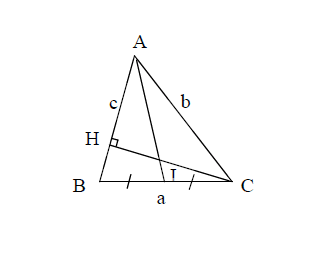Formulaire : Résumé Terminale S
Un résumé des notions fondamentales à connaître pour le Bac.
Complexes
M(x,y) dans (O;i,j) a pour affixe z:z=x+iy dans C
Le conjugué de z est : zˉ=x−iy
Module de z:∣z∣=zzˉ=x2+y2
Forme trigonométrique : z=ρ(cosθ+isinθ) où θ=angle(i,OM)[2π]
Forme exponentielle : z=ρeiθ (avec ∣z∣=ρ et θ = angle (i,OM) = argument de z)
Conjugué de z : zˉ=ρe−iθ
Soient A et B d'affixes zA zB alors AB a pour affixe zB−zA et AB=∣zB−zA∣
Propriétés des modules
∣zˉ∣=∣z∣ ; ∣∣∣∣z1∣∣∣∣=∣z∣1 ; ∣zz′∣=∣z∣∣z′∣
Propriétés des arguments
argzz′=argz+argz′[2π]
arg(z′z)=argz−argz′[2π]
Transformations usuelles
Soit une transformation telle que M(z)→M′(z′)
-
Translation de vecteur u d'affixe t:z′=z+t
-
Homothétie de centre Ω d'affixe ω et de rapport k:z′−ω=k(z−ω)
-
Rotation de centre Ω d'affixe ω et d'angle θ:z′−ω=eiθ(z−ω)
Equations du second degré dans C
Soit l'équation az2+bz+c=0 et le discriminant Δ=b2−4ac
- si Δ>0 alors 2 solutions réelles :
z1=2a−b+Δ ; z2=2a−b−Δ
et z1z2=ac; z1+z2=a−b
z1=2a−b+iΔ; z2=2a−b−iΔ
et z1z2=ac; z1+z2=a−b
- si Δ̸=0 alors az2+bz+c=a(z−z1)(z−z2) et si Δ=0 alors : az2+bz+c=a(z−z0)2
Identités remarquables
(a+b)3=a3+3a2b+3ab2+b3
a3+b3=(a+b)(a2−ab+b2)
(a−b)3=a3−3a2b+3ab2−b3
a3−b3=(a−b)(a2+ab+b2)
(a+b)n=an+(n1)an−1b+...+(nk)an−kbk+....+(nn−1)abn−1+bn
Les suites
-
Suites arithmétiques de raison r et premier terme u0 Alors : un+1=un+r ou un=u0+nr
-
Somme de n termes consécutifs de la suite = "nbre de termes" • 2"1erterme"+"dernier"
En particulier : 1+2+3+.........+n=2n(n+1)
- Suites géométriques de raison q et premier terme u0 alors un+1=q.un ou un=u0qn
Somme de n termes consécutifs de la suite = "1erterme" •
1−q1−qnombredetermes avec q̸=1
En particulier : 1+x+x2+x3+.........+xn=1−x1−xn+1 (x̸=1)
Les fonctions logarithme et exponentielles
e0=1 ; ea+b=eaeb ; ea−b=ebea ; (ea)b=eab ; lne=1 ;
ln1=0 ; lnab=lna+lnb ;lnba=lna−lnb
ax=exlna ; lnax=xlna ; y=ex⟺x=lny
Les limites usuelles de fonctions
x→+∞limlnx =+∞
x→+∞limex =+∞
x→−∞limex =0
x→+∞limxex =+∞
x→−∞limxex =0
x→+∞limxlnx =0
x→+∞limxnex =+∞
x→+∞limxnlnx =0
x→−∞limxnex =0
x→+∞limxne−x =0
x→0limlnx =−∞
x→0limxlnx =0
x→0limxsinx =1
x→0limx1−cosx =0
x→0limxln1+x =1
x→0limxex−1 =1
Les dérivées primitives
| f(x) |
f′(x) |
| k |
0 |
| x1 |
x2−1 |
| lnx |
x1 |
| cosx |
−sinx |
| x |
1 |
| xn1 n∈N |
xn+1−n |
| ex |
ex |
| sinx |
cosx |
| xn |
nxn−1 |
| x |
2x1 |
| ax |
axlna |
| tanx |
cos2x1 |
Opérations et application des dérivées
| (u+v)′=u′+v′ |
(ku)′=ku′ |
| (uv)′=u′v+uv′ |
(u1)′=u2−u′ |
| (u′)′=2uu′ |
(un)′=nu′un−1 |
| (vu)′=v2u′v−uv′ |
(v∘u)′=u′.v∘u |
| (eu)′=u′eu |
lnu′=u′u |
- Equation de la tangente à la courbe Cf en A(a;f(a)):y=f′(a)(x−a)+f(a)
Calcul intégral - Les équations différentielles
Si F primitive ce f alors :
∫abf(t)dt=F(b)−F(a) et si g(x)=∫axf(t)dt alors g′(x)=f(x)
∫abf(t)dt=−∫baf(t)dt
∫acf(t)dt=∫abf(t)dt+∫bcf(t)dt
∫abf(t)dt=α∫abf(t)dt+β∫bag(t)dt
si a⩽b et f⩾0 alors
∫abf(t)dt⩾0 ; si a⩽b et f⩽g alors a∫abf(t)dt⩽∫abg(t)dt
si a⩽b et m⩽f⩽M alors m(b−a)⩽∫abf(t)dt⩽M(b−a)
Intégration par parties
∫abu(t)v′(t)dt=[u(t)v(t)]ab−∫abu′(t)v(t)dt
Equations différentielles
Les solutions de y′=ay+b sont des fonctions f(x)=Ceax−ab où C est un réel.
Les Probabilités
Dénombrements
n!=1×2×3×…×n avec 0!=1 et (n+1)!=n!×(n+1).
Le nombre de combinaisons de p éléments pris parmi n est noté (np)
(np)=p!n(n−1)...(n−p+1)=p!(n−p)!n! ; (np)=(nn−p) ; (np)=(n−1n−p)+(n−1p) ; (n1)=n
Développement
(a+b)n=an+(n1)an−1b+...+(nk)an−kbk+...+bn
Généralités :
P(A∪B)=P(A)+P(B)−P(A∩B) ; P(Aˉ)=1−P(A) ; P(Ω)=1 ; P(⊘)=0
En cas d'équiprobabilité :
P(A)=nombred′eˊleˊmentsdeΩnombred′eˊleˊmentsdeA = "nombredecaspossibles""nombredecasfavorables"
Proba de B sachant A :PA(B)=P(A)P(A∩B); si A et B sont indépendants P(A∩B)=P(A)×P(B)
Trigonométrie - Produit scalaire
Formules d'addition
-
cos(a+b)=cosacosb−sinasinb
-
cos(a−b)=cosacosb+sinasinb
-
sin(a+b)=sinacosb+cosasinb
-
sin(a−b)=sinacosb−cosasinb
Formules de duplication
cos(2a)=cos2a−sin2a=2cos2a−1=1−2sin2a
sin(2a)=2sinacosa
Valeurs remarquables
|
0 |
6π |
4π |
3π |
2π |
π |
| sin |
0 |
21 |
22 |
23 |
1 |
0 |
| cos |
1 |
23 |
22 |
21 |
0 |
−1 |
| tan |
0 |
33 |
1 |
3 |
n'existe pas |
0 |
Produit scalaire
u et v tels que u=OA ; v=OB ; soit θ=angle(OA,OB) alors
u∙v=OA∙OB=OA×OB×cosθ
si u(x;y) et v(x′;y′) alors u∙v=xx′+yy′
si OB se projette en OH sur OA alors
- u∙v=OA×OH (si les vecteurs sont de même sens)
- u∙v=−OA×OH (si sens contraires)
u et v sont orthogonaux u∙v=0
Al Khashi :
a2=b2+c2−2bccosA
Théorème de la médiane :
c2+b2=2AI2+2a2
Aire du triangle :
S=21bcsinA
Formule des sinus :
sinAa=sinBb=sinCc
Equation de droite :
ax+by+c=0 équation de D qui admet pour vecteur directeur u(−b;a) et normal ("⊥") v(a;b).

Toutes nos vidéos sur les notions à connaître absolument pour le bac s
